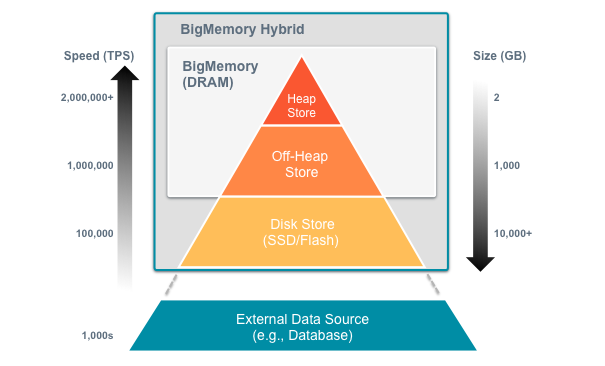About BigMemory Hybrid
BigMemory Hybrid is an optional extension to BigMemory Max that:

Enables scaling up to economical solid-state drive (SSD) flash memory motionless "disks" in conjunction with conventional dynamic random-access memory (DRAM) memory. This means that the cache size can exceed the available off-heap memory.

Provides predictable low latency at very large scale.

Manages the data flow seamlessly and automatically from DRAM to flash "disk" according to the size of the cache.

Performs much faster than conventional hard disks, although not quite as fast as a pure DRAM in-memory solution.

Supports searching, Fast Restart backup and recovery, Web Sessions, Quartz, and WAN replication.

Works with industry-standard SSD devices from popular vendors, such as Fusion IO and Intel SSD.
How it works
For use in Terracotta servers, when using BigMemory Hybrid, all data is stored in SSD/Flash drives. The keys are stored in off-heap memory, providing optimal performance when using Hybrid (though there is an option to store cache keys on disk, but this comes with a performance penalty and is not recommended).
Figure 1. BigMemory Hybrid allows you to expand BigMemory in Terracotta servers, keeping more data closer to your application for increased transactions per second (TPS).
How is BigMemory Hybrid different than Overflow to Disk?
BigMemory Hybrid | Overflow to Disk |
Available in version 4.1 | Available in version 3.7 |
Leverages BigMemory's Fast Restart technology | Depends upon Berkeley DB to store data on disk |
Manages all data in SSD/Flash for predictable performance. Only the cache keys are stored in off-heap memory. | If data does not fit in off-heap, it is pushed to disk, hence performance is less predictable |
Optimized for SSD usage | No optimization done for SSDs |
